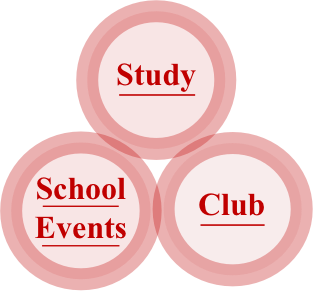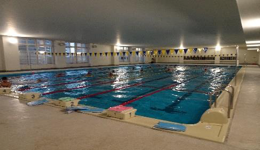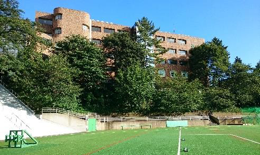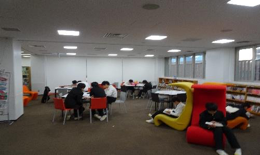我等は百難打越し行かん
Warera-wa-hyakunan-uchikoshi-yukan (We will overcome any difficulties on our way)
The Academy lives by two mottos. The first motto is “kyu-ten-jikki”(九転十起),which means “Rise again every time you fall.”

This lyric is the ending part of our school song.
Soichiro Asano, the founder of the School, was a person who always made an effort. The word “Kyu-ten-jikki” meaning “Rise again every time you fall” is one of our school mottos, which reflects his attitude toward life. Making mistakes itself is nothing to be ashamed of; what is important here is not to give up after mistakes, to learn from them and to keep on challenging. This is the spirit of making strenuous efforts to move forward. The School recognizes student effort and nourishes our students’ minds so they will never give up.
We are committed to “development of individuals who can serve and contribute to society.” It is very important, therefore, for you to find something that you love and you feel interested in, and eventually to search for a path that you should take. The answer lies within yourself. If you fully devote yourself to your daily classroom learning and club activities as well as school events including preparations, you will experience various feelings and thoughts, and start to see something new opens up for you. Based on these efforts, I would like you to get engaged in serving others, cooperating with people around you while committing yourself faithfully, and keep challenging yourselves without giving in to mistakes.
I hope that throughout your six years here, you will find many things that you will cherish, including your future dreams, lifetime friends, and even successful and unsuccessful experiences. I believe they will become a priceless asset of your life.
School Principal 
History
The Asano Academy was founded in 1920 by Soichiro Asano, the renowned Japanese entrepreneur and founder of several companies, such as: Taiheiyo Cement Corporation and JFE Steel Corporation.
The Academy’s aim was to cultivate members of society who could be constructive in an industrial society. The academy was reorganized as Asano Junior High School (Grades 7-9) and Asano Senior High School (Grades 10-12) following World War II and the subsequent national educational system reform. In that decade, the school’s facilities were updated, including a school library, a gymnastic hall, and a school field. 2020 will mark the centennial anniversary of the school’s foundation.
School Information
The Asano Academy is a private boys’ school located in the center of Yokohama City. The Academy consists of Asano Junior High School (Grades 7-9) and Asano Senior High School (Grades 10-12) with approximately 800 students respectively. Celebrating its 100-year anniversary in 2020, the Academy is accredited by the Kanagawa Prefectural Board of Education, in compliance with the Japanese Ministry of Education, Culture, Sports, Science & Technology.
The Asano Academy was founded in 1920 by Soichiro Asano, a renowned Japanese entrepreneur and founder of several companies, such as: Taiheiyo Cement Corporation and JFE Steel Corporation. Admission to the Junior High School is highly competitive. Every year, 270 out of approximately 1800 applicants are selected for admission, based on their scores during entrance examinations.
School Motto”九転十起” & Philosophy
The school motto of 九転十起 (Kyu-Ten-Jukki) means, “Rise again every time you fall.” We believe that we can achieve our goals by continuously making efforts and persevering. This strong spirit of perseverance comes from the academy’s founder, Soichiro Asano, who spent his life contending with many ups and downs. The school’s educational goal is to nurture individuals who possess mental toughness, thoughtfulness, and awareness of responsibility, as well as a broad outlook and deep sensitivity.
Educational Feature
The Academy aims to bring a well-balanced education based on what we call the “Three Main Pillars.” These being: studying, school events and club activities.

All of our students study hard to enter their selected universities. However, we do NOT think that passing their university entrance exams is the only purpose of their education. Through many school events and club activities, the students learn to communicate with not only their friends in the same grade, but with those in different grades. In doing so, they foster human relationships, share feelings of happiness or regret, act on their own initiatives, and find their own ways of living.
Award-Winning Club Activities, Year 2015-2017
The International Chemistry Olympiad
Shortlisted for national representatives, 2016
The International Conference of Model United Nations in New York
Participated, May 2017
Debate,
The Japan HEnDA prepared-English debate Championship 1st Best Communication Score, 2016
The Model United Nations for all SHS students in Japan, Prize for Outstanding
Ambassador Role, 2016The Japan PDA improvised-English debate Championship 3rd Place, 2016
Sho-gi (Japanese Chess),
The Japan Championship for JHS students, Participated, 2016
The Japan Championship for SHS students, Participated, 2016
Boxing,
The Japan Championship (fly weight),
Participated 2015
Students Council
Students Council intends to foster their self-governing spirit and develop mind and body through their responsible behavior based on the school motto” Love & Group-Oriented” and “ 九 転 十 起 (Kyu-Ten-Jukki).” In addition to the council’s six permanent committees, School Festival, Sports Day and JHS’s Sporting Event are voluntarily planned and operated by each executive committee of the council.



Matriculation of 2018-2020
Asano’s curriculum is based on the standards and requirements of the Japanese government for high school education. For more detailed information on this curriculum, see below. At Asano, the students work hard to study subjects above and beyond the required curriculum, and the teachers are very eager to offer academic guidance and assistance. Due to this extra effort, almost all of Asano Graduates enter an institution of higher education, mostly in Japan. 43% go on to national or public universities, 50% enter private universities and 9% to medical schools. Recently, there are even a few students going abroad for higher education. All Asano students are very competitive. We are proud of our students’ efforts and the teachers’ support.
| Class of: | 2020 | 2019 | 2018 | |
|---|---|---|---|---|
| National and Public Universities | ||||
| The University of Tokyo | 39 | 39 | 42 | |
| Kyoto University | 1 | 8 | 5 | |
| Hitotsubashi University | 17 | 16 | 15 | |
| Tokyo Institute of Technology | 27 | 20 | 26 | |
| Private Universities | ||||
| Keio University | 143 | 188 | 138 | |
| Waseda University | 114 | 174 | 109 | |
| Medical Schools | ||||
| National | 13 | 20 | 17 | |
| Private | 31 | 28 | 26 | |
School Calendar and Hours
The Japanese academic year begins in April and ends in March, with three terms. April – mid-July (First Term), September – December (Second Term) and January – March (Third Term). The numbers in the column indicate hours per week for each subject. The circled numbers are for elective subjects, while the rest is compulsory. Daily lessons consist of six 50-minute periods. Students must earn 36 credits in Grades 10 and 11 and 30-34 in Grade 12 for graduation. Term examinations take place 5 times a year.
| SUBJECTS | school hour 1st year |
school hour 2nd year |
school hour 2nd year |
school hour 3rd year |
school hour 3rd year |
|---|---|---|---|---|---|
| humanities course | the science course | humanities course | the science course | ||
| Integrated Japanese Language | 6 | ||||
| Contemporary Japanese Language B | 3 | 2 | 4 | 2 | |
| Classics B | 3 | 3 | 4 | 3 | |
| World History A | 2 | ||||
| World History B | ⑤ | ||||
| Japanese History B | ⑤ | ||||
| Geography A | 2 | 3 | |||
| Geography B | ④ | ||||
| Contemporary Society | 2 | ||||
| Intensive Study of World History A | ④ | ||||
| Intensive Study of Japanese History A | ④ | ||||
| Intensive Study of World History B | ⑦ | ||||
| Intensive Study of Japanese History B | ⑦ | ||||
| Intensive Study of Geography | ③ | ||||
| Intensive Study of Civics | |||||
| Mathematics I | |||||
| Mathematics II | 3 | ||||
| Mathematics III | 4 | 4 | 3 | ||
| Mathematics A | 5 | ||||
| Mathematics B | 3 | ||||
| Intensive Study of Mathematics | 1 | 2 | 3 | ||
| Basic Physics | 3 | ||||
| Advanced Physics | 2 | ||||
| Basic Chemistry | ④ | ④ | |||
| Advanced Chemistry | 2 | ||||
| Basic Biology | 2 | ||||
| Advanced Biology | ④ | ④ | |||
| Basic Earth Science | 3 | ||||
| Intensive Study of Basic Chemistry | ③ | ||||
| Intensive Study of Basic Biology | ③ | ||||
| Physical Education | 2 | 2 | 2 | 3 | 3 |
| Health | 1 | 1 | 1 | ||
| Music I | ① | ② | ② | ||
| Art and Design I | ① | ② | ② | ||
| Calligraphy I | ① | ② | ② | ||
| English Communication I | 3 | ||||
| English Communication II | 4 | 4 | |||
| English Communication III | 4 | 4 | |||
| English Expression I | 3 | ||||
| English Expression II | 2 | 2 | 2 | ||
| Intensive Study of English | 2 | ||||
| Basic Home Economics | 2 | ||||
| Information Study for Participating Community the Period for Integrated Studies |
1 | 1 | 1 | ||
| the Period for Integrated Studies | 1 | 2 | 2 |
Course of Studies
Integrated Japanese Language: this course is a combination of 2 credits of Contemporary Japanese and 3 credits of Classical Japanese
Contemporary Japanese Language B: covers modern Japanese literature.
Classics B: covers classical Japanese and classical Chinese.
World History: Course A focuses on the later modern period whereas Course B is an overview of all recorded history.
Japanese History: Course A focuses on the later modern period whereas Course B is an overview of all recorded history.
Geography Course A: focuses on raising global perspectives through learning world geography, whereas Course B: mainly focuses on studying topography to understand the features of each region.
Mathematics I: Algebra, Trigonometric Ratio, Quadratic Functions
Mathematics II: Equation of Higher Degrees, Exponential and Logarithmic Functions, Trigonometry
Mathematica III: Differential and Integral Calculus, Limits, Complex Plane
Mathematics A: Counting Probability, Integers and Figures
Mathematics B: Probability Distribution and Statistics, Sequences, Vectors
Grading System
The Asano Academy adopts a 5-point Japanese grading scale, according to the student’s performance, and examination scores achieved during the term. Therefore, the student’s GPA is calculated based on the 5-point scale.
Grade 5: represents an unweighted average score of 80% and higher
Grade 4: represents 65% and higher
Grade 3: is average and represents 45% and higher
Grade2: students must pass a make-up test
Grade1: means “failing”
Like most Japanese high schools, the Asano Academy does not introduce “Advanced Placement” or “Honors” courses. We offer our students the opportunity to explore advanced content in their field of interest in each subject, or in a wider variety of areas.
For any questions, please feel free to contact us. Thank you.
Contact Us
Asano Academy/Asano Junior and Senior High School
Chairman of the Board: Hajime Asano
Principal of the School: Hiroyuki Kokaji
ADDRESS: 1-3-1 Koyasudai, Kanagawa-ku, Yokohama City, Kanagawa Prefecture, 221-0012 JAPAN TEL: +81-45-421-3281 FAX: +81-45-421-4080
http://www.asano.ed.jp/





